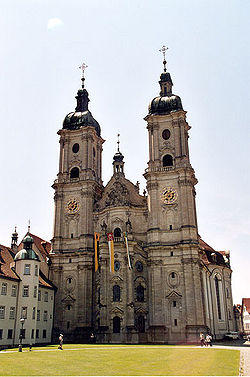Abbey of St. Gall
| Cathedral of St Gall | |
|---|---|
| The Cathedral of Saint Gall | |
| Kathedrale St. Gallen | |

|
|
| Coordinates: 47°25′23″N 9°22′38″E / 47.42306°N 9.37722°E | |
| Location | St. Gallen |
| Country | Switzerland |
| Denomination | Roman Catholic |
| Website | Website of the Cathedral |
| History | |
| Founded | 8th century |
| Architecture | |
| Status | Active |
| Functional status | Cathedral |
| Heritage designation | UNESCO World Heritage Site |
| Style | Baroque |
| Administration | |
| Diocese | Roman Catholic Diocese of Saint Gallen |
| Clergy | |
| Bishop(s) | Markus Büchel |
| Official name | Cathedral and Abbey of Saint Gall |
| Type | Cultural |
| Criteria | ii, iv |
| Designated | 1983 (7th session) |
| Reference no. | 268 |
| State Party | Switzerland |
| Region | Europe |
| Princely Abbey of Saint Gall | ||||||||||
| Fürstabtei St. Gallen | ||||||||||
| Imperial Abbey of the Holy Roman Empire | ||||||||||
|
||||||||||
| Capital | St. Gallen | |||||||||
| Languages | High Alemannic | |||||||||
| Government | Principality | |||||||||
| Historical era | Middle Ages, Renaissance, Baroque | |||||||||
| • | Monastery founded | 719 | ||||||||
| • | Became a Princely Abbey | 1207 | ||||||||
| • | Became Old Swiss Confederacy protectorate | August 17, 1451 | ||||||||
| • | Pillaged by the Old Swiss Confederacy | 1712 | ||||||||
| • | Secularised to Helvetic Republic canton of Säntis | 1798 | ||||||||
| • | Helvetic Republic collapsed; city and abbey became part of the newly founded canton of St. Gallen |
1803 |
||||||||
|
||||||||||
The Abbey of Saint Gall (German: Abtei St. Gallen) is a Roman Catholic religious complex in the city of St. Gallen in Switzerland of a dissolved abbey (747-1805). The Carolingian-era monastery has existed since 719 and became an independent principality between 9th and 13th centuries, and was for many centuries one of the chief Benedictine abbeys in Europe. It was founded by Saint Othmar on the spot where Saint Gall had erected his hermitage. The library at the Abbey is one of the richest medieval libraries in the world. The city of St. Gallen originated as an adjoining settlement of the abbey. Following the secularization of the abbey around 1800 the former Abbey church became a Cathedral in 1848. Since 1983 the whole remaining abbey precinct has been a UNESCO World Heritage Site.
Around 613 Gallus, according to tradition an Irish monk and disciple and companion of Saint Columbanus, established a hermitage on the site that would become the monastery. He lived in his cell until his death in 646. in Arbon. The people kept looking for protection at Gallus' cell in time of danger.
Following Gallus' death, Charles Martel appointed Otmar as custodian of St Gall's relics. Several different dates are given for the foundation of the monastery, including 719, 720, 747 and the middle of the 8th century. During the reign of Pepin the Short, in the 8th century, Othmar founded the Carolingian style Abbey of St Gall, where arts, letters and sciences flourished. The abbey grew fast and many Alemannic noblemen became monks. At the end of abbot Otmar's reign, the Professbuch mentions 53 names. Two monks of the Abbey of St Gall, Magnus von Füssen and Theodor, founded the monasteries in Kempten and Füssen in the Allgäu. With the increase in the number of monks the abbey grew stronger also economically. Much land in Thurgau, Zürichgau and in the rest of Alemannia as far as the Neckar was transferred to the abbey due to Stiftungen. Under abbot Waldo of Reichenau (740–814) copying of manuscripts was undertaken and a famous library was gathered. Numerous Anglo-Saxon and Irish monks came to copy manuscripts. At Charlemagne's request Pope Adrian I sent distinguished chanters from Rome, who propagated the use of the Gregorian chant. In 744, the Alemannic nobleman Beata sells several properties to the abbey in order to finance his journey to Rome.
...
Wikipedia

